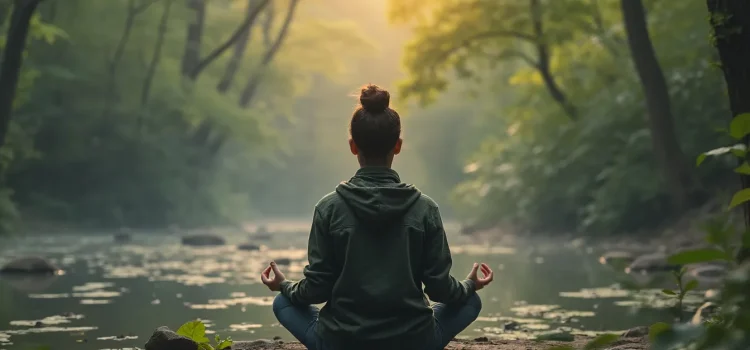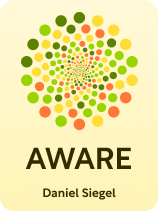

This article is an excerpt from the Shortform book guide to "Aware" by Daniel Siegel. Shortform has the world's best summaries and analyses of books you should be reading.
Like this article? Sign up for a free trial here.
Is your mind constantly racing, making it difficult to find inner peace? Would you like to cultivate a deeper sense of awareness and connection to yourself and others?
The Wheel of Awareness meditation, as described by Daniel J. Siegel in Aware, guides you through different aspects of your experience. With this practice, you explore physical sensations, thoughts, emotions, and your sense of interconnectedness with the world around you.
Continue reading to learn how the Wheel of Awareness can transform your meditation practice.
Prepare to Do the Wheel of Awareness Meditation
Before you start practicing the Wheel of Awareness meditation, Siegel recommends you prepare and strengthen your focused attention skills with some basic meditation techniques that focus on your breath. Siegel recommends you practice breath meditation on a regular basis before diving into the Wheel.
To practice simple breath meditation:
- Find a quiet, comfortable space free of distractions. Get into a comfortable sitting position with your back straight, or lie down if that’s more comfortable for you. Keep your eyes open or closed as needed—whichever helps you maintain alertness better.
- Breathe through your nose if possible. Focus on the sensation of the air moving in and out of your nostrils, and try to let that sensation become the sole focus of your attention.
- Move your attention to the sensations of breathing that you can feel in your chest and belly. Then let your attention rest on the sensations of breathing wherever it feels the easiest to pay attention to your breath.
- Your mind will inevitably wander from the sensation of breathing. When it does, gently bring your attention back to your breath.
Siegel suggests you adopt a kind attitude toward yourself during your meditation sessions. Don’t judge when your mind drifts—accept it as a normal part of the process.
(Shortform note: In When Things Fall Apart, Pema Chödrön explains that the kind of breath meditation Siegel recommends above is called Shamatha-vipashyana, a meditation practice from Tibetan Buddhist traditions. In Chödrön’s outline of the basic steps of Shamatha-vipashyana, she also recommends that you adopt an attitude of kindness and patience for yourself. She says when your mind drifts, you should try to notice the thought you’re having and label it as “thinking” with self-compassion. Then, release the thought, return attention to your breath, and conduct a brief body scan to reground yourself in the present moment.)
Practice the Wheel Meditation
To meditate with the Wheel, Siegel recommends you take a few moments to do the breath meditation you’ve been practicing. Then move your spoke of attention through the four Wheel sections. The full meditation takes around 30 minutes.
Section #1: Your Five Senses
First, with your eyes closed, picture the Wheel of Awareness as described above and imagine yourself in the center, the hub of awareness. Next, imagine sending your attention out from the hub like a spoke to the first section of the rim: your five senses. Begin to focus on the sensations you can perceive with each sense. Start with the sensations of hearing and move to sight, smells, taste, and touch (sensations coming in through your skin, like how your clothes feel or the temperature). Focus on each sense for at least 15 to 30 seconds.
| The Order of The Wheel Sections and The Hierarchy of Needs Siegel doesn’t explain the reasoning behind the order of the Wheel meditation sections, but the logic of the Wheel’s order—starting with the physical self and moving to the mind and then the social self—shows up in other frameworks of personal growth, such as Maslow’s pyramid of the hierarchy of needs. This psychological theory organizes human motivations into a pyramid, with basic physiological needs at the base and self-actualization at the top, suggesting that lower-level needs must be satisfied before addressing higher-level ones. Just as Maslow emphasized the fundamental importance of physical well-being, the Wheel meditation begins by grounding in your immediate physical experience by tuning into your five senses and developing mindful awareness of your body. |
Section #2: Your Body Sensations
Next, take a deep breath and move your spoke of attention to the second section of the rim: the internal sensations of your body. As you move through this section, focus your awareness on each part of your body for at least five to 15 seconds. Begin with your face, then move your awareness to your forehead, scalp, down the sides of your head, to your ears and neck. Then, move on to your shoulders and down both arms to your hands and fingers. Come back to your upper back and chest and down to your lower back and abdomen. Then, go to your hips, down both legs, feet, and toes.
Next, come back up and focus your attention on the sensations in your pelvic area, including your genitals, then up to your intestines and your stomach. Then, move up through your chest and esophagus to the inside of your mouth, the sinuses behind your cheekbones, the inside of your nose, and then back down your throat into your lungs. Feel both of your lungs expand and contract. Then, move your attention to your heart. And lastly, expand your attention and try to become aware of the inside of your entire body at once.
(Shortform note: The second section of the wheel corresponds to the second level in Maslow’s hierarchy, which relates to safety needs. As you move from external sensations to internal bodily awareness, you’ll delve deeper into your sense of physical security and comfort. Maslow emphasized the importance of feeling safe in one’s body and environment. By systematically scanning our body, we’re nurturing a sense of bodily integrity and self-awareness, which can contribute to feelings of safety and stability—key components of the second tier in Maslow’s pyramid.
Section #3: Your Mind
Now, take a deep breath and move your spoke to the third section of the wheel: the mental processes of your thoughts, memories, emotions, daydreams, and so on. In this section, don’t focus your attention on sensations. Instead, open your awareness to notice whatever comes up in your mind. Try to stay with this section for at least a minute and a half.
Recall that Siegel says there’s nothing that’s supposed to come to mind during this section—allow whatever happens in your mind to happen and just notice it. Try to notice how something like a thought or feeling first appears in your awareness—does it pop in suddenly or come on slowly? Once it’s there, does it stick around for a while or leave quickly? Does your mental space feel chaotic or clear? Can you sense a gap between each thought, memory, or emotion? Or do they rush in one right after the other?
(Shortform note: The third Wheel section aligns with the esteem needs in the middle of Maslow’s pyramid, which include the importance of feeling valued and developing a stable sense of self-worth. In the third Wheel section, you’ll explore the mental landscape that shapes your sense of self. By noticing your thoughts and feelings without judgment, you cultivate self-awareness and potentially develop a more balanced view of yourself. This practice can lead to greater self-understanding and self-acceptance, key components of healthy self-esteem in Maslow’s framework.)
Then, practice becoming aware of your own awareness. To do this, imagine bending the spoke of your attention back toward the center of the wheel so that you can practice being aware of your awareness itself. Try to become aware of your own awareness for at least one minute. Siegel writes that when first practicing the Wheel meditation, you can skip this part of the process. Instead, when doing this section, focus only on your mental thoughts as described above. Once you’ve gained mastery of the meditation, you can add in this step of becoming aware of your awareness.
(Shortform note: Developing awareness of your own awareness is one of the four foundational practices in Buddhist Satipatthana. As Buddhist meditation practitioners develop mindfulness, they not only observe thoughts, emotions, and mental states but also become aware of the part of their mind that is doing the observing. By cultivating this awareness of awareness, practitioners can gain deeper insights into the impermanent and non-self nature of all phenomena, including consciousness itself.)
Section #4: Interconnection & Kind Intentions
Again, take a deep breath and imagine moving the Spoke to the fourth section of the rim: your sense of connection to others. Begin by letting yourself become aware of your connection to the people and animals physically closest to you. Then, expand that sense of connection to the friends, family, and animals not physically close to you. Next, move your awareness to the people and animals you spend time with at work, school, and community. Then, expand your relational connection to all the beings in your neighborhood, your town or city, region or state, and then to all the beings living in your country and continent. Lastly, try to reach your sense of connection out to encompass the planet.
Finally, extend kind intentions—loving and kind well-wishes—to all the living beings in your life, especially to other people.
- Start by saying these simple expressions aloud or silently to yourself: “May all living beings be happy. May all living beings be healthy. May all living beings be safe. May all living beings flourish and thrive.”
- Next, move on to the following statements, which add more detail to the expressions: “May I be happy and live with meaning, connection, and equanimity, and a playful, grateful, joyful heart. May I be healthy and have a body that gives energy and flexibility, strength and stability. May I be safe and protected from all sorts of inner and outer harm. May I flourish, thrive, and live with ease and well-being.”
- Lastly, repeat the detailed phrases from the previous step but replace the “I” with “We” to cultivate a sense of interconnection and interrelation with the beings in your life and on the planet. For example, you’ll say, “May we be happy and live with meaning…” etc.
Siegel writes that this step, of extending kind intentions, is another step you can skip when you begin to meditate with the Wheel. Instead, you can focus only on the first aspects of this section—becoming aware of your connection to others. Then, when you’ve gained some mastery of the meditation, you can add this step in.
(Shortform note: This final section of the Wheel aligns with multiple levels of Maslow’s hierarchy. The third level of the hierarchy contains needs for love and belonging, just as Siegel’s fourth section cultivates your awareness of your interconnection with other beings. As the fourth section extends to a global perspective, it correlates to the highest level of Maslow’s hierarchy, the need for self-actualization, or reaching your full potential as an individual and community member. Just as Maslow proposed that the pinnacle of human development is transcending yourself to connect with something greater, the Wheel meditation expands awareness from the individual to the collective.)
After completing the meditation session, take a few mindful breaths and then slowly open your eyes.
The Compact Wheel Meditation
Siegel says that, after you’ve established a regular practice with the Wheel meditation, you can do a quicker version of the practice when you’re short on time. This version only takes about seven minutes. The basic premise of this version is that you use the rhythm and flow of your breath to pace each of the Wheel steps.
For example, in the first section of the wheel, match each of your five senses with a breath cycle: inhale and exhale as you pay attention to what you’re hearing, inhale and exhale as you focus on what you’re smelling, etc. End each Wheel section with an inhale breath and move the Spoke of attention to the next section with your exhale.
In the second section, match each breath cycle with a different body part as you make your way through the different areas and organs. For the third section, spend a few cycles of breath paying attention to your thoughts and a few cycles bending the Spoke back to pay attention to awareness. For the fourth section, expand awareness of your connection to larger circles of other living beings with each breath cycle. If you’re doing the step of offering kind well-wishes, play around with different ways of matching the expression with the rhythm and flow of your breath.
(Shortform note: The compact wheel is similar to vinyasa yoga, which pairs the rhythm and flow of your breath to different movements of your body. One movement in vinyasa, for example, has you lift your hands above your head when you inhale and bring them down to your sides when you exhale. In both the compact wheel and vinyasa, you change your attention and action with each breath cycle, which, according to yoga experts, can create a sense of momentum and harmony in the mind and body.)
Reflect on the Wheel Experience
As you familiarize yourself with the Wheel mediation, Siegel recommends you take time to reflect on your experiences. He recommends you journal after your sessions so that you can return to your reflections and track how things evolve along the way. He suggests the following areas of reflection:
- Notice which Wheel sections were more manageable or challenging to focus on and what feelings or memories arose. When your focus drifted away, how did it feel to gently redirect it back to the Wheel meditation?
- How did it feel to focus on every part of your body? Paying attention to physical sensations may trigger unpleasant or overwhelming feelings for you if you have past trauma. You can adapt the practice by initially spending less time on this section. Over time, you may gain greater insight from tuning into those sensations.
- What happened when you made space for mental activities to arise during the third section? Did you feel bombarded with thoughts? Was your mind quiet and empty?
- How did it feel to turn your awareness onto awareness itself? Siegel says it’s common for people to find this practice initially confusing and disorienting. He says not to worry if this is the case for you—becoming aware of awareness itself is typically seen as an advanced practice in other mediation traditions, and it takes time to get used to.
- How did it feel to express a kind intention toward yourself and others? Siegel explains that people often find it awkward or uncomfortable. But with time, you’ll become more comfortable with it and probably come to enjoy it.
| The Value of Reflection in the Learning Process Reflecting on your experiences while learning something new is a powerful tool for personal growth and skill development. Learning experts say that journaling about your progress over time is an effective way to reflect and can provide valuable insights into your learning journey. This practice allows you to identify challenges, such as when your attention drifts from your meditation; to track progress, such as being able to feel more and more of your body; and to recognize patterns in your learning process, such as sections you might get stuck or confused by. By regularly assessing your progress, you can adjust your strategies, set more realistic goals, and maintain motivation. Reflection also deepens your understanding of the subject matter by encouraging you to process and internalize new information. |

———End of Preview———
Like what you just read? Read the rest of the world's best book summary and analysis of Daniel Siegel's "Aware" at Shortform.
Here's what you'll find in our full Aware summary:
- The benefits of increasing your awareness of yourself and the world
- How to use a meditation tool called the Wheel of Awareness
- How the Wheel of Awareness improves your bodily functions






